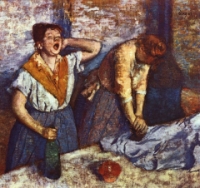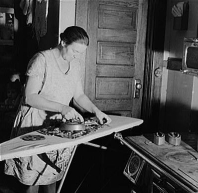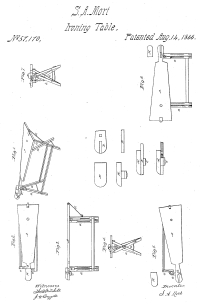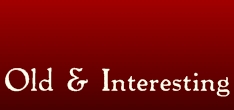-
History of:
- Resources about:
- More:
- Baby walkers
- Bakehouses
- Bed warmers
- Beer, ale mullers
- Besoms, broom-making
- Box, cabinet, and press beds
- Butter crocks, coolers
- Candle snuffers, tallow
- Clothes horses, airers
- Cooking on a peat fire
- Drying grounds
- Enamel cookware
- Fireplaces
- Irons for frills & ruffles
- Knitting sheaths, belts
- Laundry starch
- Log cabin beds
- Lye and chamber-lye
- Mangles
- Marseilles quilts
- Medieval beds
- Rag rugs
- Rushlights, dips & nips
- Straw mattresses
- Sugar cutters - nips & tongs
- Tablecloths
- Tinderboxes
- Washing bats and beetles
- Washing dollies
- List of all articles
Subscribe to RSS feed or get email updates.
No wood does so well as deal [pine or fir] for an ironing board; the heat draws out a stain from any other kind. Oak tables are very durable to be sure, but they are heavy and expensive.
Esther Copley, Cottage Comforts (1841)
For apparatus there will be one or more ironing-tables under the light; an ironing-stove (which is a close stove or hot-plate on which the irons are placed to heat); a spare table; and a mangle or its equivalent. An average ironing-table will be 6 or 8 feet by 3 or 4.
Robert Ker, The Gentleman's House: or, How to plan English residences, from the parsonage to the palace, 1865
A bosom board, on which to iron shirt-bosoms, should be made, one foot and a half long, and nine inches wide, and covered with white flannel. A skirt board on which to iron frock-skirts, should be made, five feet long, and two feet wide at one end, tapering to one foot and three inches wide, at the other end. This should be covered with flannel; and will save much trouble in ironing nice dresses. The large end may be put on the table, and the other, on the back of the chair. Both these boards should have cotton covers, made to fit them; and these should be changed and washed, when dirty.
Catherine Beecher, A Treatise on Domestic Economy , 1842
History of Ironing Boards
Ironing tables, ironing boards, ironing blankets
 It may seem obvious that
ironing has to be done on a flat surface, but there have been exceptions. Chinese
pan irons were sometimes used on cloth stretched in mid air between two people.
Ancestors of the ironing board include, in the West, the whalebone smoothing boards
buried with Viking ladies, and in the East, the stone slabs used with Korean ironing
sticks. (See 'history of ironing'
page.) The smoothing boards, about 33 cm or 1 foot long, are thought to have been
used with the glass linen smoothers also found at Viking burial sites. Boards small
enough to hold on the lap were still in use in the 19th century. Known as press
boards, these were often used for ironing seams while dressmaking, but could also
be used when pressing laundry.
It may seem obvious that
ironing has to be done on a flat surface, but there have been exceptions. Chinese
pan irons were sometimes used on cloth stretched in mid air between two people.
Ancestors of the ironing board include, in the West, the whalebone smoothing boards
buried with Viking ladies, and in the East, the stone slabs used with Korean ironing
sticks. (See 'history of ironing'
page.) The smoothing boards, about 33 cm or 1 foot long, are thought to have been
used with the glass linen smoothers also found at Viking burial sites. Boards small
enough to hold on the lap were still in use in the 19th century. Known as press
boards, these were often used for ironing seams while dressmaking, but could also
be used when pressing laundry.
 A kitchen table or a board supported by two chairs were both in common use for ironing
before the days of the mass-market folding ironing board. (See picture left of a
woman using a flatiron on a board balanced over chairs.) There was plenty of advice
in 19th century housekeeping books about what size an ironing table should be (various
opinions), what wood it should be made of (pale softwood for cleanliness, oak for
strength), and how it should be covered (thick woollen ironing-blanket in white
baize or red flannel, with a sheet or ironing-cloth on top).
A kitchen table or a board supported by two chairs were both in common use for ironing
before the days of the mass-market folding ironing board. (See picture left of a
woman using a flatiron on a board balanced over chairs.) There was plenty of advice
in 19th century housekeeping books about what size an ironing table should be (various
opinions), what wood it should be made of (pale softwood for cleanliness, oak for
strength), and how it should be covered (thick woollen ironing-blanket in white
baize or red flannel, with a sheet or ironing-cloth on top).
 Swanskin was
often recommended as an ironing blanket in England. Nothing to do with large feathered
wings, but a dense scarlet fabric used to cover ironing tables. Using your red woollen
cloak for this purpose was frowned upon by 19th century English women writers, but
it must have been quite common or it wouldn't have been mentioned so regularly.
(See quotes below) In George Washington's household at Mount Vernon in Virginia
the ironing blankets were made of thick woollen "fearnought".
Swanskin was
often recommended as an ironing blanket in England. Nothing to do with large feathered
wings, but a dense scarlet fabric used to cover ironing tables. Using your red woollen
cloak for this purpose was frowned upon by 19th century English women writers, but
it must have been quite common or it wouldn't have been mentioned so regularly.
(See quotes below) In George Washington's household at Mount Vernon in Virginia
the ironing blankets were made of thick woollen "fearnought".
 Folding ironing boards arrived
as the Victorians channelled their inventiveness into finding better ways of managing
a household. The first US patents for these appeared in the 1860s. Some shapes that
we would now call ironing boards were called ironing tables. Inventors designed
ironing bureaus, and even ironing tables combined with quilting frames. Different
boards were made for specialised tasks like ironing sleeves, and there were ironing
board accessories for special jobs like ironing bonnets. While the woman (above
right) in North Dakota in 1940 has a folding board, she is not using an electric
iron, but a sadiron with detachable handle, probably the famous
Mrs. Potts' patented iron. Note the two spare iron bases heating on the
stove.
Folding ironing boards arrived
as the Victorians channelled their inventiveness into finding better ways of managing
a household. The first US patents for these appeared in the 1860s. Some shapes that
we would now call ironing boards were called ironing tables. Inventors designed
ironing bureaus, and even ironing tables combined with quilting frames. Different
boards were made for specialised tasks like ironing sleeves, and there were ironing
board accessories for special jobs like ironing bonnets. While the woman (above
right) in North Dakota in 1940 has a folding board, she is not using an electric
iron, but a sadiron with detachable handle, probably the famous
Mrs. Potts' patented iron. Note the two spare iron bases heating on the
stove.
This US patent from 1866 (left) described "A new and Improved Ironing-Board adapted
principally for the use of ladies’ dress and other skirts, shirt-fronts, or any
piece of clothing that requires to be ironed single, and, with the bonnet-block
attached to the neck of the ironing board, bonnets and other pieces of clothing
may be ironed with great advantage . . The nature of my invention consists in an
improvement in the ordinary ironing board, over which it possesses many advantages.
It is lighter and durable, and when extended it can be placed anywhere, and when
not in use can be folded to the capacity of an ordinary board, which renders it
very convenient."
Don't even think of using your red cloak on your ironing table!
None but a complete slattern would use her red cloak for an ironing blanket.
Esther Copley, Cottage Comforts (1825)... her best red cloak, which she always used for her ironing cloth on Sundays, for her cloak when she travelled, and for her blanket at night; such a wretched manager was Rachel!
Hannah More, Black Giles the Poacher (1796)… the white deal table at which [an old woman] was busy ironing; her red cloak being laid for an ironing cloth; her hand still retaining its hold upon the iron which she had been slowly moving…
Maria Louisa Charlesworth, The Cottage and its Visitor (1856)
<<<< irons & smoothers >>>> irons for frills
...the press-board on her knee, where she is pressing the next year's Sunday vest of Zephaniah Pennel. As she makes her heavy tailor's goose squeak on the work...
Harriet Beecher Stowe, The Pearl of Orr's Island (1862)
You may like our new sister site Home Things Past where you'll find articles about antiques, vintage kitchen stuff, crafts, and other things to do with home life in the past. There's space for comments and discussion too. Please do take a look and add your thoughts. (Comments don't appear instantly.)
For sources please refer to the books page, and/or the excerpts quoted on the pages of this website, and note that many links lead to museum sites. Feel free to ask if you're looking for a specific reference - feedback is always welcome anyway. Unfortunately, it's not possible to help you with queries about prices or valuation.


